Social media is a powerful facet of a successful marketing strategy. When used effectively, it can create brand awareness, foster meaningful connections with your target audience, and generate sales.
Using social media effectively, however, is not always as easy as it sounds. Creating social media content for your brand or organization can be intimidating, but have no fear! Anyone can leverage the power of social media marketing with these top tips for creating posts that get seen, connect, and convert.
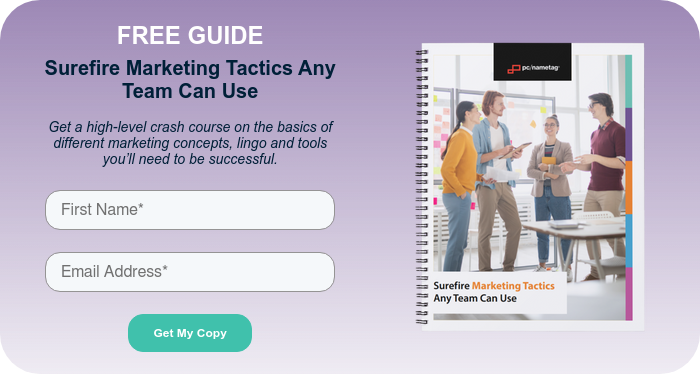
1. Develop a unique brand voice
Some of the most successful brands and influencers on social media might not be who you think they are. Brands like Scrub Daddy and the midwestern gas station chain Kwik Trip have developed a unique and voice that have helped them garner loyal followings on TikTok and Twitter, respectively.
While the humorous approach these brands take may not work for every brand on every platform, it still shows the importance of developing a voice. Today's consumers see right through the run-of-the-mill corporate jargon and brand speak. They will not give the time of day to accounts that post the same self-promotions in different words day after day. Social media users want to be entertained, feel understood, and find value in your content.
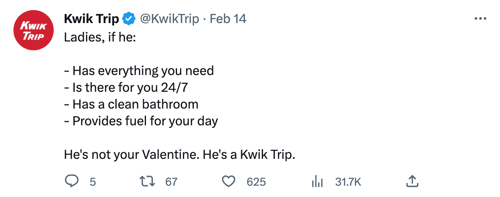 Kwik Trip has developed a unique voice on Twitter that goes over well with their Millennial and Gen Z audience.
Kwik Trip has developed a unique voice on Twitter that goes over well with their Millennial and Gen Z audience.
The rise of influencer culture has pushed brands to be more "relatable" in their social media strategy. While brands like Scrub Daddy and Kwik Trip use social media to post memes and jokes, others develop their “voice” by having honest interactions with followers or by featuring interesting and informative content.
JetBlue Airways, for instance, is sixth in the U.S. in terms of passengers carried per year, but they've gained more Twitter followers than any of their much larger competitors because they've built a reputation for being quick and honest in their customer interactions.
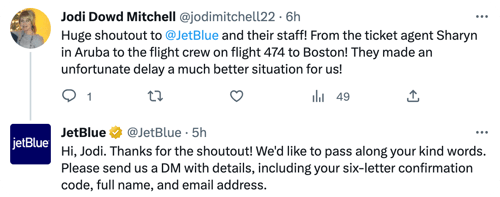
JetBlue has gained popularity by not only posting fun and entertaining content, but also by being responsive to both positive and negative customer experiences. They also encourage customers to share their stories by Promising to pass feedback along to employees also encourages people to share their stories.
The key is to be human, not a robot. Your posts should sound like an actual person is writing them, not like they have been copied and pasted from a corporate document.
2. Research how your target audience uses social media
As marketers, we know there are a lot of social media platforms out there. Most people think of Twitter, Facebook, LinkedIn, YouTube and Instagram as the primary channels to promote their brand, but today, there's also Snapchat, TikTok, Pinterest, Tumblr, Reddit and other more niche platforms.
There's a belief among some that your brand needs to be on every social media platform to stay relevant and grow an audience. This simply isn't true, nor manageable. Take time to learn your target audience, identify which platforms they use most frequently, and focus on nailing those first.
TikTok, for instance, is a newer platform and one of the better ones for growing organically. This makes it a great tool for many organizations, especially those with a younger target audience in the "Gen Z" and "Millennial" age bracket.
 TikTok Users by Age. Source: Wallaroo
TikTok Users by Age. Source: Wallaroo
However, if the target audience consists primarily of people in their 50s and 60s, it may be worth your time to build up other platforms first before you start creating trendy TikTok videos.
A great tool for researching your audience is SparkToro, which lets you identify which social platforms your audience uses most. You'll also find podcasts they listen to, websites they visit, hashtags they use most frequently, and even which political affiliation they lean towards. You can use this information to evaluate advertising opportunities and refine your brand voice.
 SparkToro helps find information about your audience based on what they frequently post on social media.
SparkToro helps find information about your audience based on what they frequently post on social media.
One tip that has helped in our own social media marketing strategy is to identify the three to five top platforms where your audience spend the most time, and develop a unique “mission statement” for each of those platforms.
For instance, your TikTok’s primary purpose may be to entertain, while your Facebook is used for company culture posts, and your Twitter used for customer service and community management. Not every brand will use every platform in the same way, so it’s important to find out what works best for you.
Social media mission statement examples
Here are some social media mission statements similar to our own that may help inspire you to create yours:
-
We are on Facebook to engage with brand evangelists by posting team culture posts that humanize our brand and build trust.
-
We are on Instagram to increase brand recognition among our target audience by posting aesthetically pleasing product photography and reels.
-
We are on LinkedIn to build trust with our current and potential customer base by sharing educational resources and tools.
-
We are on Twitter to create relationships with brands and influencers in our industry by initiating and participating in industry-relevant conversations.
-
We are on TikTok to grow our audience organically by posting entertaining and relatable content for our target customer.

3. Share relevant content from across the Internet
Is your business’s social media profile filled with nothing but self-promotion posts? If so, it’s time for a change. In these situations, you run the risk of coming across as too “sales-y” and self-serving, and your followers’ social feeds are definitely filled with enough paid advertisements already.
Instead, make your page more appealing by sharing content from other brands and influencers alongside your own original posts. If you see something you think would be helpful or intriguing to your audience, share it! Add value by including your own insight, asking a question, or highlighting a useful quote when you share.
A key tip when it comes to sharing content on social media, especially something like a podcast or blog post, is to make sure the post itself is helpful without requiring a click-through. You want your posts to get shares, and people tend to prefer sharable content that is useful at face value.
 This Twitter thread highlighting useful resources for marketers has 190 replies, 2,000 retweets, and 8,000 likes.
This Twitter thread highlighting useful resources for marketers has 190 replies, 2,000 retweets, and 8,000 likes.
For instance, you could create a thread of useful online resources that would be helpful to your potential prospects. Or, turn a popular blog post into a short Twitter thread highlighting the key points of the blog, and then link to the blog post in the final tweet of the thread for more details. This will perform better than linking to the blog right off the bat and expecting people to click through. You need to build trust first.
Don’t forget to tag the influencer or brand that originally posted the content so they will see that you liked their post and thought it was worth sharing. Not only can this be a great way to build relationships within your industry, but it could also inspire opportunities for cross-promotions or guest blogging in the future, both of which can improve your content strategy and grow your audience massively.
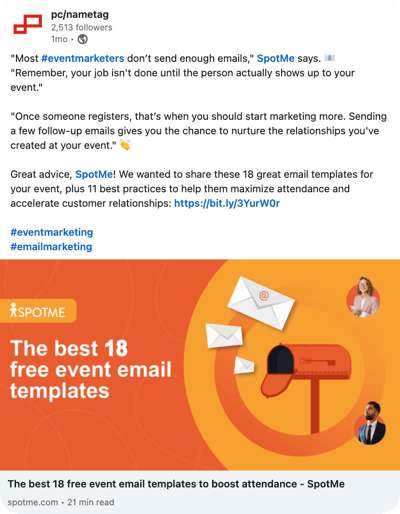 An example of an educational resource shared on LinkedIn, tagging the original source.
An example of an educational resource shared on LinkedIn, tagging the original source.
4. Start an industry related Facebook group
The Facebook algorithm has gone through some major changes in the past few years, and it's now incredibly unlikely that organic posts from your business page will be seen by your followers. Facebook instead prioritizes family and friend content, paid advertisements, and group content in its users’ newsfeeds.
Facebook groups have peaked in popularity and are now the primary content being shared to users' feeds. Try creating one to take advantage of organic growth opportunities.
Make your Facebook group a fun, casual space for your fans, followers, and potential prospects to interact with each other. Try not to make the group topic directly related to your business, unless your brand is already well known and widely adored.
 This group was created by a wedding DJ based in Wisconsin and has grown to over 9,000 members.
This group was created by a wedding DJ based in Wisconsin and has grown to over 9,000 members.
Instead, think of a fun topic or a problem that pertains to your industry or business. For instance, if you work for a wedding planning company, try creating a group with a fun name - like "Wedding Wins" or "Wedding Ideas I Wish I Had Thought Of" - that encourages brides and grooms to share photos of their big day and advice with others who are planning their wedding.
As the group admin, you can add comments and posts about your own products and services, but only when appropriate and applicable.
You can also make the group private and add qualifying questions for new members to make sure your group participants are legitimately interested in the topic. This allows you to have group members agree to certain group "rules" as well, to help minimize spam and toxicity.
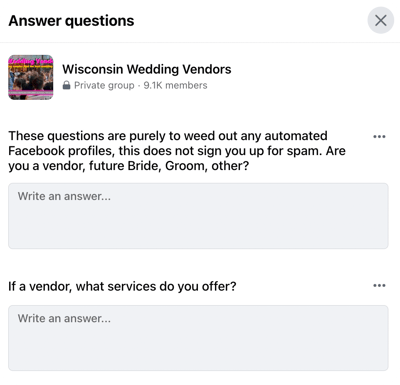 You can ask any question you want to new members of your Facebook group to ensure they are a good fit.
You can ask any question you want to new members of your Facebook group to ensure they are a good fit.
5. Use paid social advertising to promote your brand
One you have created awesome, relatable social media content on the right channels for your audience, it’s time to make sure that people see what you’re posting.
Like we mentioned, algorithm changes have made it increasingly difficult for content to be seen organically. This means finding promotional opportunities is key to increasing your reach and, by proxy, your web traffic and revenue.
Leveraging paid social ads is key, as all social media platforms prioritize ads over organic posts. Most platforms have the option to create advertisements once you have a business profile.
Start by creating a Facebook and/or Instagram ad since they have the most user-friendly interface. Target your page's followers with a simple product or service advertisement to see how it performs.
Once you are able to, try out some retargeting strategies. Make sure your website is set up with a Meta Pixel so you can target those who have visited a specific page of your website with a relevant ad.
The “Rule of Seven” that states someone needs to hear a brand message seven times before they take an action is a fairly old concept, but it still applies today. Make sure your prospects are seeing your message multiple times, and you’ll have a much higher chance of them converting.
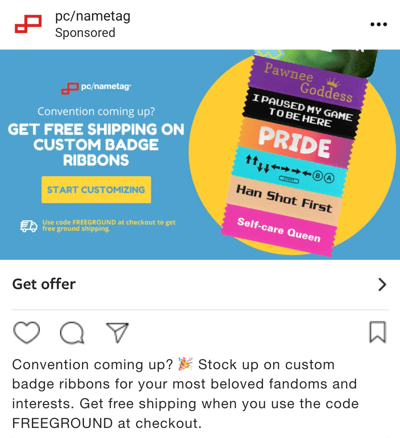 A Facebook ad we ran targeting customers who had upcoming events and had perviously purchased ribbons.
A Facebook ad we ran targeting customers who had upcoming events and had perviously purchased ribbons.
Paid social ads aren’t the only promotional opportunity out there, though. Influencer marketing has also been a massive trend in recent years. Identify key influencers in your space and find out how you can work with them in a mutually beneficial relationship.
For example, send them a free product in exchange for an honest review in a TikTok video or Instagram story. Give them a specific offer code to promote, and in return, they'll get a portion of the revenue generated using that code. Ensure there is a contract with timeline and terms laid out ahead of time.
Final thoughts on successful social media marketing
The Internet contains a goldmine of useful tips, tricks and tools to help you take full advantage of the crazy world of social media marketing.
While there’s no “right” or “wrong” way to handle your organization’s social accounts, the greatest advice we can give is to not be afraid to do something different.
Your social profiles don’t have to look like all your competitors. In fact, it’s probably best if they don’t! While there is no magical formula for going viral, prioritize trying new things and helping your audience feel more connected to your brand. Remember, building a successful social media strategy takes time.
Tell Us: What's your best social media advice?
What social media hints do you have to share? If it's useful to you, chances are it'll be useful to someone else. Let us know by leaving a comment below. 💕READ NEXT:
- 11 Event Promotion Ideas to Market Your Meeting and Attract Attendees
- How to Become a Better Marketing Content Writer
- Creative Direct Mail Tips: How to Boost Responses and Save Money




Submit a Comment